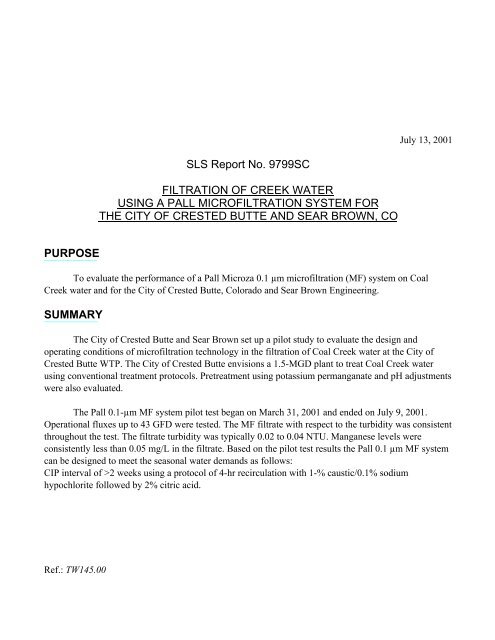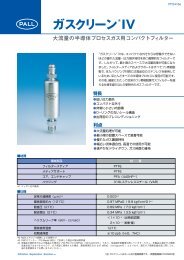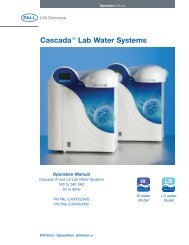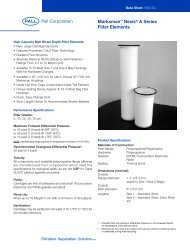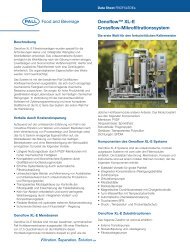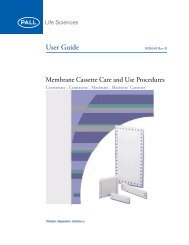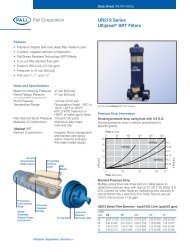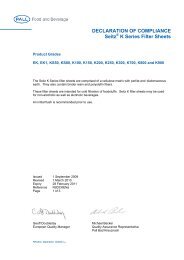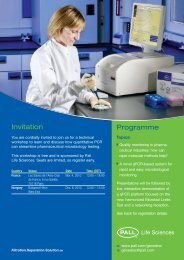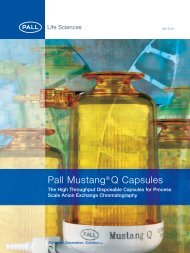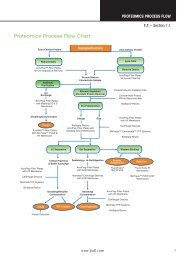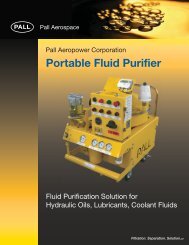Filtration Of Creek Water Using A Pall Microfiltration System For The ...
Filtration Of Creek Water Using A Pall Microfiltration System For The ...
Filtration Of Creek Water Using A Pall Microfiltration System For The ...
You also want an ePaper? Increase the reach of your titles
YUMPU automatically turns print PDFs into web optimized ePapers that Google loves.
July 13, 2001<br />
SLS Report No. 9799SC<br />
FILTRATION OF CREEK WATER<br />
USING A PALL MICROFILTRATION SYSTEM FOR<br />
THE CITY OF CRESTED BUTTE AND SEAR BROWN, CO<br />
PURPOSE<br />
___________<br />
To evaluate the performance of a <strong>Pall</strong> Microza 0.1 µm microfiltration (MF) system on Coal<br />
<strong>Creek</strong> water and for the City of Crested Butte, Colorado and Sear Brown Engineering.<br />
SUMMARY<br />
___________<br />
<strong>The</strong> City of Crested Butte and Sear Brown set up a pilot study to evaluate the design and<br />
operating conditions of microfiltration technology in the filtration of Coal <strong>Creek</strong> water at the City of<br />
Crested Butte WTP. <strong>The</strong> City of Crested Butte envisions a 1.5-MGD plant to treat Coal <strong>Creek</strong> water<br />
using conventional treatment protocols. Pretreatment using potassium permanganate and pH adjustments<br />
were also evaluated.<br />
<strong>The</strong> <strong>Pall</strong> 0.1-µm MF system pilot test began on March 31, 2001 and ended on July 9, 2001.<br />
Operational fluxes up to 43 GFD were tested. <strong>The</strong> MF filtrate with respect to the turbidity was consistent<br />
throughout the test. <strong>The</strong> filtrate turbidity was typically 0.02 to 0.04 NTU. Manganese levels were<br />
consistently less than 0.05 mg/L in the filtrate. Based on the pilot test results the <strong>Pall</strong> 0.1 µm MF system<br />
can be designed to meet the seasonal water demands as follows:<br />
CIP interval of >2 weeks using a protocol of 4-hr recirculation with 1-% caustic/0.1% sodium<br />
hypochlorite followed by 2% citric acid.<br />
Ref.: TW145.00
This report is proprietary to PALL CORPORATION and is furnished in Confidence for the Private use of the intended recipient, for the sole purpose of evaluating<br />
PALL technology. It may not be copied nor disclosed, in whole or in part, without the prior express approval of PALL CORPORATION.<br />
This report is proprietary to PALL CORPORATION and is furnished in Confidence for the Private use of the intended recipient, for the sole purpose of evaluating PALL<br />
technology. It may not be copied nor disclosed, in whole or in part, without the prior express approval of PALL CORPORATION.
BACKGROUND<br />
________________<br />
<strong>The</strong> City of Crested Butte processes Coal <strong>Creek</strong> water from two existing conventional treatment<br />
sites under the authority of the Crested Butte <strong>Water</strong> Treatment Plant. <strong>The</strong> conventional treatment utilizes<br />
coagulation, flocculation, sedimentation and mixed media filtration. <strong>The</strong> exiting conventional treatment<br />
plant produces enough potable water to meet demands with favorable raw water conditions. However,<br />
future expansion of the service area will require a modification of the current water treatment system.<br />
One proposed solution is the implementation of membrane technology<br />
<strong>The</strong> City of Crested Butte is interested in evaluating the <strong>Pall</strong> Microfiltation (MF) system for the<br />
design on a proposed 2-MGD expansion of the Crested Butte water treatment plant (WTP). <strong>The</strong> <strong>Pall</strong><br />
<strong>Microfiltration</strong> system was selected for pilot testing as a viable membrane technology. <strong>The</strong> <strong>Pall</strong> pilot test<br />
started on March 31, 2001 and ended on July 7, 2001. Operating and performance data from the <strong>Pall</strong><br />
pilot and test results from the City of Crested Butte and Sear Brown were collected and presented in this<br />
report.<br />
TEST EQUIPMENT & OPERATION:<br />
_____________________________________<br />
A fully automated pilot system was installed at the City of Crested Butte WTP test site. <strong>The</strong><br />
process flow diagram is shown in Figure I. <strong>The</strong> system was equipped with one <strong>Pall</strong> Microza MF<br />
membrane with the physical characteristics described in Table I.<br />
FIGURE I<br />
Schematic <strong>Pall</strong> Microza MF Pilot <strong>System</strong><br />
FT<br />
PT<br />
TI<br />
PT<br />
S2<br />
UPPER<br />
RF DISCHARGE<br />
FT<br />
PT<br />
AIR INJ .<br />
RF PUMP<br />
S1<br />
FEED PUMP<br />
LOWER<br />
RF DISCHARGE<br />
This report is proprietary to PALL CORPORATION and is furnished in Confidence for the Private use of the intended recipient, for the sole purpose of evaluating PALL<br />
technology. It may not be copied nor disclosed, in whole or in part, without the prior express approval of PALL CORPORATION.
TABLE I<br />
Test Module Microza XUSV-5203<br />
Outside Membrane Area 398 ft 2<br />
Module Length<br />
2 meters<br />
Module Diameter<br />
5 inches<br />
Membrane Material<br />
PVDF<br />
Housing Material<br />
PVC<br />
<strong>The</strong> Microza hollow-fiber membrane was operated in an outside-to-inside mode with periodic<br />
regeneration of the membrane by a simultaneous air scrubbing/reverse flow (SASRF) followed by a<br />
reverse flow (RF). <strong>The</strong> excess recirculation (XR) rate for this pilot study was 10% of filtrate. <strong>The</strong> pilot<br />
system operates at a constant filtrate flow rate. <strong>The</strong> operating conditions are shown in Table II.<br />
TABLE II<br />
Summary of Operating Conditions<br />
Filtrate<br />
Flux Based on Outside Area<br />
Recirculation Rate<br />
SASRF (frequency, duration, flowrate)<br />
Cycle 1 (3/30 to 4/5)<br />
(4/5 to 5/3)<br />
Cycle 2 (5/4 to 5/17)<br />
(5/18 to 5/21)<br />
Cycle 3 (5/22 to 5/30)<br />
(6/1 to 6/8)<br />
Cycle 4 (6/8 to 6/17)<br />
(6/19 to 7/9)<br />
RF (frequency, duration, flowrate)<br />
Cycle 1 (3/30 to 4/5)<br />
(4/5 to 5/3)<br />
Cycle 2 (5/4 to 5/17)<br />
(5/18 to 5/21)<br />
Cycle 3 (5/22 to 5/30)<br />
(6/1 to 6/8)<br />
Cycle 4 (6/8 to 6/17)<br />
(6/19 to 7/11)<br />
7.7 to 12 GPM<br />
27.9 to 43.4 GFD<br />
10% of filtrate<br />
30 min, (30 sec air/60 sec air + filtrate), 5 gpm<br />
30 min, (0 sec air/90 sec air + filtrate), 5 gpm<br />
30 min, (0 sec air/70 sec air + filtrate), 5 gpm<br />
30 min, (30 sec air/60 sec air + filtrate), 5 gpm<br />
30 min, (30 sec air/60 sec air + filtrate), 5 gpm<br />
30 min, (30 sec air/60 sec air + filtrate), 5 gpm<br />
30 min, (30 sec air/60 sec air + filtrate), 5 gpm<br />
30 min, (30 sec air/60 sec air + filtrate), 5 gpm<br />
30 min, 20 sec, 10 gpm<br />
30 min, 20 sec, 10 gpm<br />
30 min, 20 sec, 10 gpm<br />
30 min, 20 sec, 15 gpm<br />
30 min, 20 sec, 14 gpm<br />
30 min, 20 sec, 12 gpm<br />
30 min, 20 sec, 12 gpm<br />
30 min, 20 sec, 13 gpm<br />
This report is proprietary to PALL CORPORATION and is furnished in Confidence for the Private use of the intended recipient, for the sole purpose of evaluating PALL<br />
technology. It may not be copied nor disclosed, in whole or in part, without the prior express approval of PALL CORPORATION.
Typically when the transmembrane pressure (TMP) reaches a maximum of 35 psid, the<br />
membranes are chemically cleaned in place (CIP) with a solution of 1 % NaOH and 1,000 ppm NaOCl<br />
followed by a solution of 2% citric acid. Makeup water was potable water. <strong>The</strong> CIP consisted of a 4-hr<br />
recirculation of the NaOH/chlorine followed by a 2-hr recirculation with citric acid.<br />
Prior to the start of the test, an integrity test was performed to ensure that the test membrane is<br />
integral. A pressure decay rate of
TEST RESULTS AND DISCUSSION<br />
_____________________________________<br />
1. <strong>Pall</strong> MF Performance and Operation:<br />
<strong>For</strong> the duration of pilot program, the MF was evaluated under the operational parameters and<br />
characteristics summarized in Table III.<br />
TABLE III<br />
Date<br />
Cycle<br />
#<br />
Interval<br />
(days)<br />
Membrane Operational Characteristics<br />
TMP<br />
initial/final<br />
(psi)<br />
Flux<br />
(GFD)<br />
Date of<br />
CIP<br />
Temp<br />
Range<br />
(C)<br />
Feed<br />
NTU<br />
Recovery<br />
(%)<br />
3/30-4/5 1 7 3/7 27.9 0.7-1.2 1-4 96.2<br />
4/5-5/3 28 9/21 32.6 5/3 0.5-4.2 2-8 95.7<br />
5/4-5/18 2 14 5/33 32.6 5/18 (a) 3.0-9.4 6-8 96.4<br />
5/18-5/21 3 16/22 32.6 5/22 8.1-10.7 6-8 96.0<br />
5/22-5/30 3 8 3/8 32.6 8.3-12.8 3-6 96.2<br />
5/30-6/8 10 9/11 39.8 8.8-13.1 3-4 97.1<br />
6/8-6/12 4 12/25 43.4 6/14 (b) 11.7-14.5 2-3 97.2<br />
6/14-6/17 3 12/34 43.4 6/18 8.8-11.6 2-3 97.2<br />
6/19-7/11 4 22 5/18 (c) 39.8 97.0<br />
(a); (b); maintenance clean of 0.5% citric RF flush for 15 min<br />
(c); 2-ppm chlorine added to SASRF and RF starting on 7/2<br />
a. Cycle 1 (March 30 to May 3):<br />
<strong>The</strong> cycle started on March 30 with a flux of 27.9 GFD with an initial TMP 3 psid.<br />
<strong>The</strong> TMP increase was a minimal 4-psi after 7 days. <strong>The</strong> flux was increased to 32.6 GFD on<br />
April 5. <strong>The</strong> run continued until May 3 with a TMP increase to 21 psid. <strong>The</strong> total run time for<br />
cycle 1 was 35 days (Figure II). <strong>The</strong> feed turbidity was 1 to 8 NTU with a temperature range<br />
of 0.7 to 4.2C. <strong>The</strong> filtrate turbidity was consistently 0.02 to 0.04 NTU with a particle count<br />
of < 1 count/ml for particle sizes > 2µm. <strong>The</strong> pilot was CIP on May 3.<br />
b. Cycle 2: (May 4 to May 21):<br />
<strong>The</strong> cycle started on May 4 with a flux of 32.6 GFD with an initial TMP of 5 psid. <strong>The</strong> cycle<br />
continued for 14 days until terminal TMP of 33 psid was reached. A maintenance clean<br />
consisting of a 2% citric acid recirculation for 1 hour was then performed. This was successful<br />
in reducing the TMP to 16 psid. <strong>The</strong> microfiltration pilot was restarted and the cycle was<br />
continued until May 21 with a final TMP of 22 psid. <strong>The</strong> total time for cycle 2 was 17 days<br />
This report is proprietary to PALL CORPORATION and is furnished in Confidence for the Private use of the intended recipient, for the sole purpose of evaluating PALL<br />
technology. It may not be copied nor disclosed, in whole or in part, without the prior express approval of PALL CORPORATION.
(Figure III). <strong>The</strong> feed turbidity was 6 to 8 NTU with a temperature range of 3.0 to 10.7C. <strong>The</strong><br />
filtrate turbidity was consistently 0.02 to 0.04 NTU with a particle count of < 1 count/ml for<br />
particle sizes > 2u. <strong>The</strong> microfiltration pilot was CIP on May 22.<br />
c. Cycle 3 (May 22 to June 17):<br />
Cycle 3 started on May 22 with a flux of 32.6 GFD with an initial TMP of 3 psid. <strong>The</strong><br />
TMP gradually increased to 8 psid over the next 8 days. On May 30 the flux was increased to<br />
39.6 GFD with an initial TMP of 9 psid. <strong>The</strong> TMP increased to 11 psid over the next 10 days.<br />
On June 8 the flux was increased to 43.6 GFD with an initial TMP of 12 psid. <strong>The</strong>re was a<br />
rapid TMP increase to 25 psid in the next 4 days. A maintenance clean consisting of a 2%<br />
citric acid recirculation for 1 hour was performed on June 14. This produced a TMP recovery<br />
to 12 psid. <strong>The</strong> cycle was continued for 3 more days until terminal TMP was reached. <strong>The</strong><br />
total run time for cycle 3 was 25 days (Figure IV). <strong>The</strong> feed turbidity during cycle 3 was 3 to<br />
6 NTU with a temperature range of 8.3 to 14.5C. <strong>The</strong> filtrate turbidity was consistently 0.02 to<br />
0.04 NTU with a particle count of < 1 count/ml for particle sizes > 2µm. <strong>The</strong> microfiltration<br />
pilot was CIP on June 18.<br />
d. Cycle 4 (June 19 to July 11):<br />
Cycle 4 started on June 19 with a flux of 39.6 GFD with an initial TMP of 5 psid. <strong>The</strong><br />
TMP gradually increased to 25 psid over the next 13 days. On July 2, chemical addition of 2-<br />
ppm chlorine in the SASRF and RF cycles was initiated. <strong>The</strong> immediately reduced the TMP<br />
to 20 psid. <strong>The</strong> cycle continued for another 9 days with the TMP remaining flat at 20 psid.<br />
<strong>The</strong> test period was ended on July 11 without reaching TMP. <strong>The</strong> total run time for cycle 4<br />
was 22 days (Figure V). <strong>The</strong> feed turbidity during cycle 4 was 0.2 to 3 NTU with a<br />
temperature range of 13 to 19 C. <strong>The</strong> filtrate turbidity was consistently 0.02 to 0.04 NTU with<br />
a particle count of < 1 count/ml for particle sizes > 2 µm.<br />
2. Turbidity Trends:<br />
Raw and filtrate turbidity trends can be seen in the previous graphs. <strong>The</strong> feed turbidity<br />
was typically 2 to 3 NTU. During spring runoff, the turbidity was typically 6 to 8 NTU. <strong>The</strong><br />
filtrate turbidity was consistently 0.02 to 0.04 NTU.<br />
3. Particle Count Trends:<br />
Raw and filtrate particle count trends can be seen in Figures VI through IX. <strong>The</strong> feed<br />
counts of greater than 2µm were typically 20,000 to 30,000 counts/ml. <strong>The</strong> filtrate counts of<br />
greater than 2µm were typically less than 1 count/ml.<br />
4. Manganese Results:<br />
This report is proprietary to PALL CORPORATION and is furnished in Confidence for the Private use of the intended recipient, for the sole purpose of<br />
evaluating PALL technology. It may not be copied nor disclosed, in whole or in part, without the prior express approval of PALL CORPORATION.
<strong>The</strong> manganese concentration in the filtrate were consistently < 0.05 mg/L when<br />
potassium permanganate was used in pretreatment of raw water and sodium hypochlorite was<br />
dosed into the raw water and filtrate backwash.<br />
5. <strong>Water</strong> Analysis Data:<br />
<strong>Water</strong> analysis data for Coal <strong>Creek</strong> water are summarized below in Table IV.<br />
TABLE IV<br />
Coal <strong>Creek</strong> <strong>Water</strong><br />
(Courtesy of Crested Butte WTP and Sear Brown)<br />
Parameter<br />
Range<br />
Total Alkalinity (mg/L as CaCO 3 ) 12-26<br />
Bicarbonate (mg/L as HCO) 15-31<br />
Carbonate (mg/L as CO 3 )
______________________________<br />
Scott Caothien<br />
Director<br />
Scientific and Laboratory Services<br />
West Coast Division<br />
<strong>Pall</strong> Corporation<br />
____________________________<br />
Paul Morris<br />
Field Engineer<br />
Scientific and Laboratory Services<br />
West Coast Division<br />
<strong>Pall</strong> Corporation<br />
This report is proprietary to PALL CORPORATION and is furnished in Confidence for the Private use of the intended recipient, for the sole purpose of<br />
evaluating PALL technology. It may not be copied nor disclosed, in whole or in part, without the prior express approval of PALL CORPORATION.


